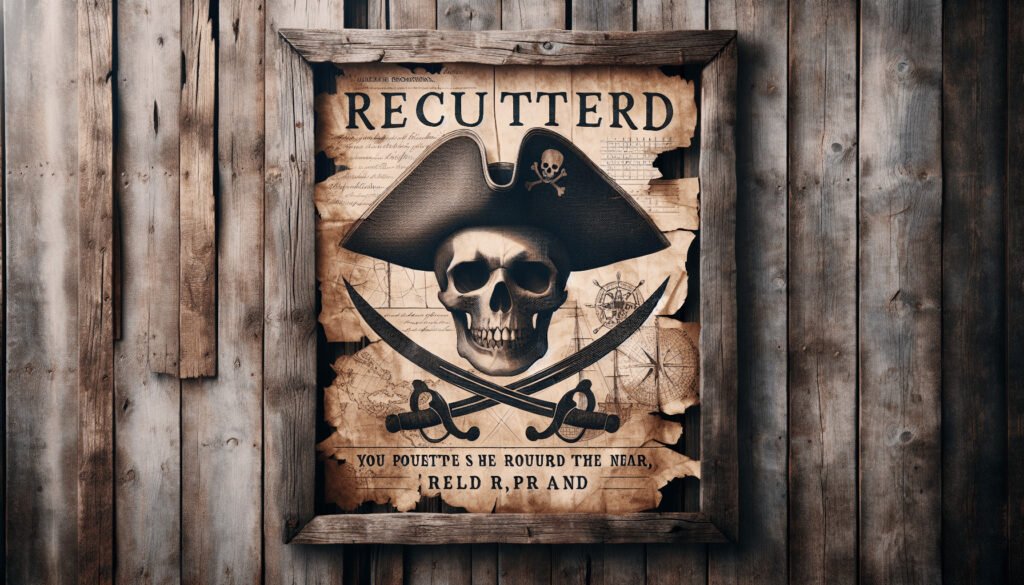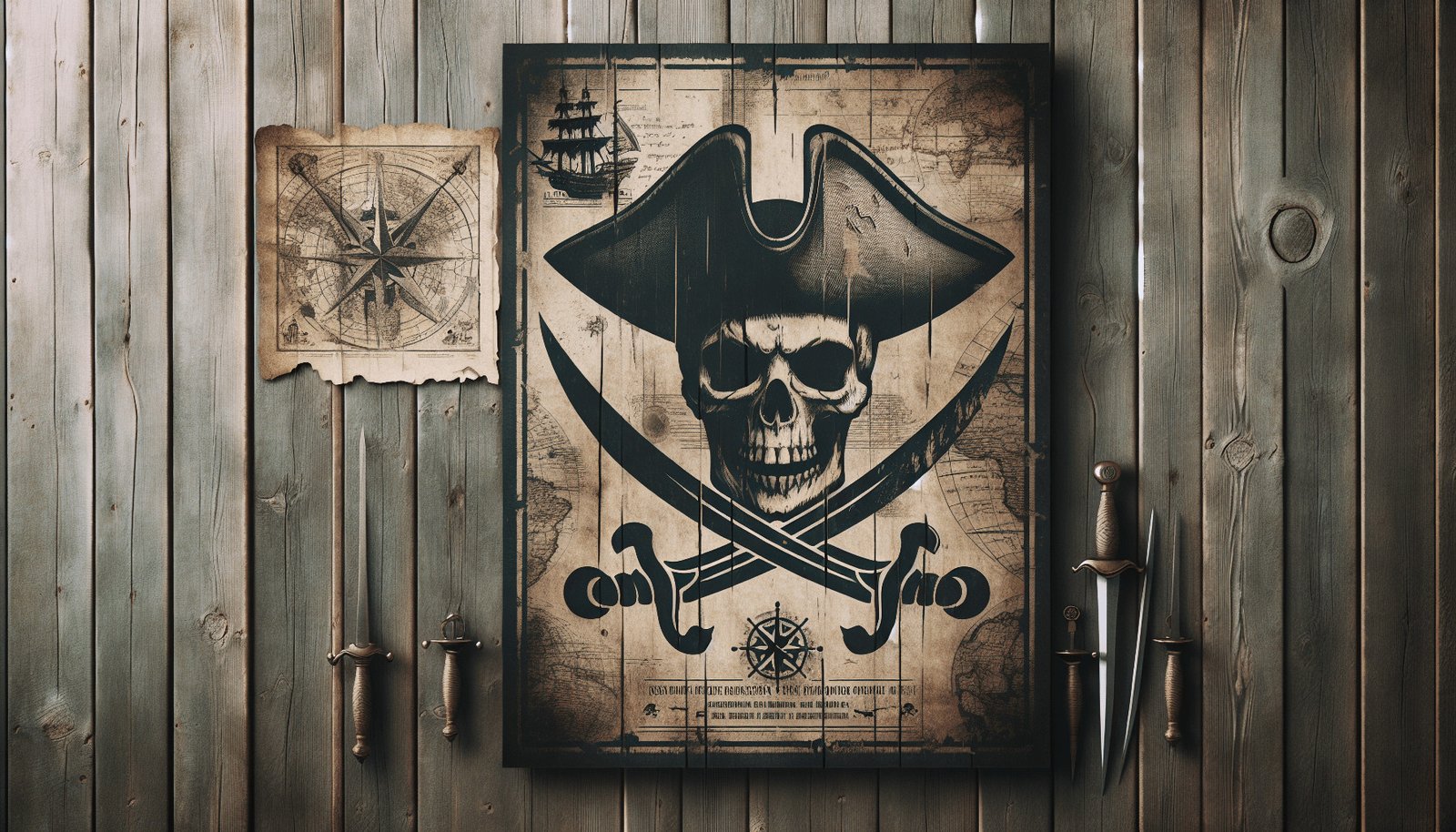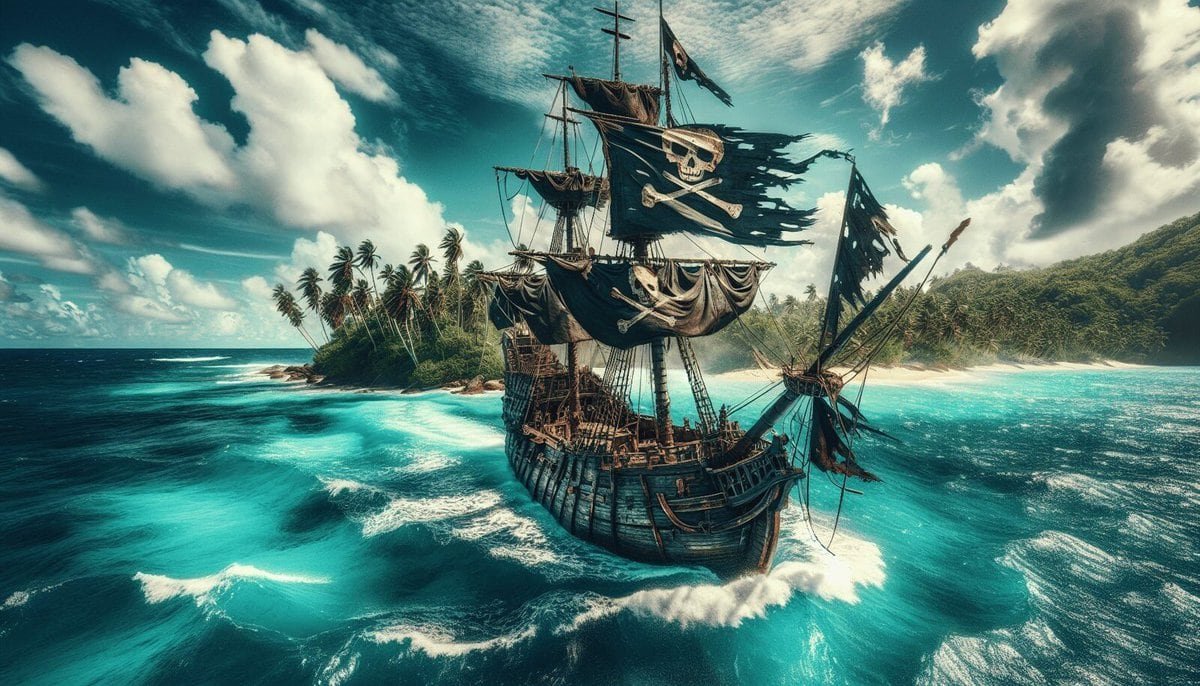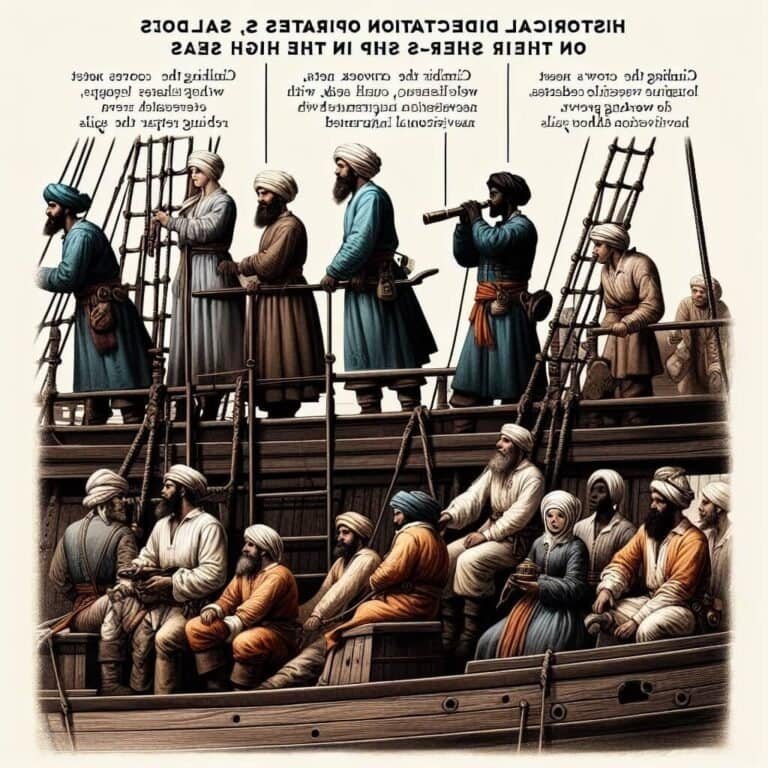Have you ever wondered what a pirate recruitment poster might look like if it were created by the love child of Banksy and Joan Rivers? You know, something that could have you laughing while questioning your entire life’s purpose? Let’s set sail on a journey through the hilariously dark and deeply irreverent art of pirate recruitment posters and discover how these salty seafarers perfected the art of persuasive propaganda.
The Allure of the Pirate Life: Flawed Romance on the High Seas
Imagine, if you will, that you’re stuck in a dead-end job in 18th-century England. Working as a chimney sweep, you’re covered in soot more often than you’re covered in glory. Then, you spot a poster that invites you to join a pirate crew. Suddenly, the promise of adventure, treasure, and rum looks better than your current prospects. That’s the power of these cheeky posters.
A Life Less Mundane: The Fantasy
Pirate recruitment posters played on the romantic ideal of a life filled with adventure. Think less “die of scurvy” and more “buried treasure and endless rum.” They promised a better life, where you could take what you want and answer to no one. Not quite the glossy Instagram life we see today, but close enough for the dirty-faced desperate folks of yesteryear.
The Cost of Freedom: Small Print in Blood
Here’s the kicker: these posters didn’t exactly tell the whole story. Join a pirate crew, and sure—you might find treasure. But you might also lose a leg, catch syphilis, and discover that your new job involves a lot more keel-hauling than sunbathing. The posters were the original clickbait, focusing on the highs and conveniently glossing over the lows.
Anatomy of a Pirate Recruitment Poster
Let’s dissect one of these masterpieces to see how they managed to be both irresistibly enticing and morbidly funny. Picture a poster with a big skull and crossbones at the top, some fancy cursive text, and a liberal dose of gallows humor.
The Header: Grab ‘Em by the Eyeballs
Just like today’s marketing wizards, pirates knew you needed a killer headline. Something like “Join the Fight for Freedom and Fortune” or “Why Settle for Pennies When You Can Steal Pounds?” It’s hard to argue with logic that appeals to your direct and basest desires.
The Subtext: Dark Humor and Sarcasm
Under the header, you’d find a mix of promises and thinly veiled threats. “Enjoy a lifetime of adventure—until your likely untimely death!” It’s like reading the side effects of a highly addictive drug, but with more sea shanties and fewer legal repercussions.
Sex Sells (or Not): Gender Roles on the High Seas
And let’s not forget the hyper-masculine vibe these posters often exuded. They presented piracy not just as a job, but as a proving ground for manhood. As for women, well, they were more likely to be part of the loot than part of the crew. Although, let’s be real, female pirates did exist and they were as badass as they come, often wearing men’s clothes and taking no prisoners. Literally.

The Sales Pitch: Anchors Away and No Healthcare
Now, let’s really analyze the sales pitch. It consisted of a few key points that mirrored today’s infomercials but with a lot more rum and fewer fake doctors.
Unlimited Wealth: Treasure and Trinkets
“Why earn a meager wage when you could rob someone else’s?” It’s basically the early version of multi-level marketing. Everyone in the crew had a stake in the loot, adding a veneer of democracy to the whole operation.
Freedom from Tyranny: No Bosses, Only Captains
One key selling point was the lack of traditional authority figures. You weren’t answering to some snooty Lord Taxamore; you were on equal footing with your crew—until you weren’t. Because political coups were as common as scurvy in pirate ships. But hey, minor oversight, right?
Constant Adventure: More Drama than Reality TV
The posters promised constant excitement. From battling rival ships to evading the law, it was one adrenaline rush after another. Forget about repetitive desk work, this was the kind of gig that had plot twists more often than a soap opera.
Dark Humor as a Tool for Persuasion
Ah, the brilliance of dark humor—making you laugh at things you probably shouldn’t and convincing you that danger is just another word for fun. Pirate recruitment posters were rife with this technique.
Normalizing Predicaments: Laughing Through Pain
Using humor, these posters managed to normalize the grim realities of pirate life. You might lose a limb, but who needs two legs when you can always get a stylish peg leg? Davy Jones’ Locker became less of a terrifying oceanic grave and more of a playful metaphor for a life well-lived and lost.
Relatability Through Cynicism: Universality of Misery
It wasn’t just the hardship of the sea that was laughed at; it was the universal misery of human existence. Whether you were scrubbing a floor or scrubbing the deck, life was a series of unfortunate events. Better to laugh about it with a mug of rum in hand.
Gallows Humor: A Morbidly Fresh Perspective
And let’s not overlook gallows humor—the kind of jokes that derived their punch from the proximity of death and disaster. Favored in pirate circles, it’s akin to the jokes you hear in an ER—if the ER were staffed entirely by people sticking it to society’s conventions.

Marketing Strategy Beyond the Poster
Let’s be honest: recruitment posters were just the gateway drug. Pirates had an entire marketing strategy that would make any modern marketer weep with envy.
Pirate Branding: Flags and Symbols
The Jolly Roger flag—a simple, universally recognized icon of piracy. Much like a brand logo, it told you exactly who you were dealing with. Seeing that flag on the horizon meant you were in for either a world of hurt or a career change.
Word of Mouth: Infamy and Tales of Glory
Pirates relied heavily on word of mouth. The tales of their exploits—often exaggerated because let’s face it, who doesn’t embellish a good story?—served as walking advertisements.
Testimonials and Fear: From the Horse’s Mouth
When a former pirate speaks, people listen. And when they testify to the thrilling life at sea, you’re more likely to grab that sword and sign up. Fear also played a role: you’d rather be on the winning side of a pirate raid than the subject of one.
Irreverent Persuasion: Lessons for Today
If marketing gurus of today could take a leaf out of the pirates’ playbook, they’d find some timeless wisdom hidden in those irreverently persuasive tactics.
Authenticity Sells: No Gloss, Just Grit
Pirate recruitment posters were raw and honest, albeit exaggerated. In today’s market, where consumers value authenticity, this approach is pure gold. No one buys “perfect”—they buy “real.”
Appeal to Basic Instincts: Money, Freedom, Adventure
Humans haven’t changed much. We still chase after wealth, freedom, and excitement. The fundamentals of marketing remain the same, so focusing on these primal desires will likely always be effective.
Dark Humor: Laughing Through Adversity
Dark humor has a place in today’s pseudo-empathetic world. Life is hard; we’re all a little messed up. A touch of gallows humor shows you’re in on the joke, and people appreciate that level of authenticity.
Building a Brand: Strong Symbols
Strong branding is another trick right out of the pirate handbook. If your brand can be universally recognized—whether it’s a logo, a slogan, or a product—you’ve got the kind of visibility most brands dream of.
Conclusion: Pirates and the Art of Irreverent Persuasion
So, what can a snarky, rum-fueled recruitment poster from the 18th century teach us today? Quite a lot, it appears. Pirates mastered irreverent persuasion by combining basic human desires with a sarcastic, darkly humorous tone. They used authenticity, bold promises, and gallows humor to not only recruit but also build an enduring, unmistakable brand.
As you navigate through the sea of modern marketing, take a page from their book. Be bold. Be funny. And most importantly, be real. Because at the end of the day, whether you’re selling a product or the dream of a pirate’s life, it’s the story you tell—and how you tell it—that hooks people in.
Aye, the road to persuasion is paved with wit, grit, and a dash of delightful cynicism. So, arm ye marketing campaigns and set sail for uncharted territories. Your audience will thank you—with or without the peg leg.

